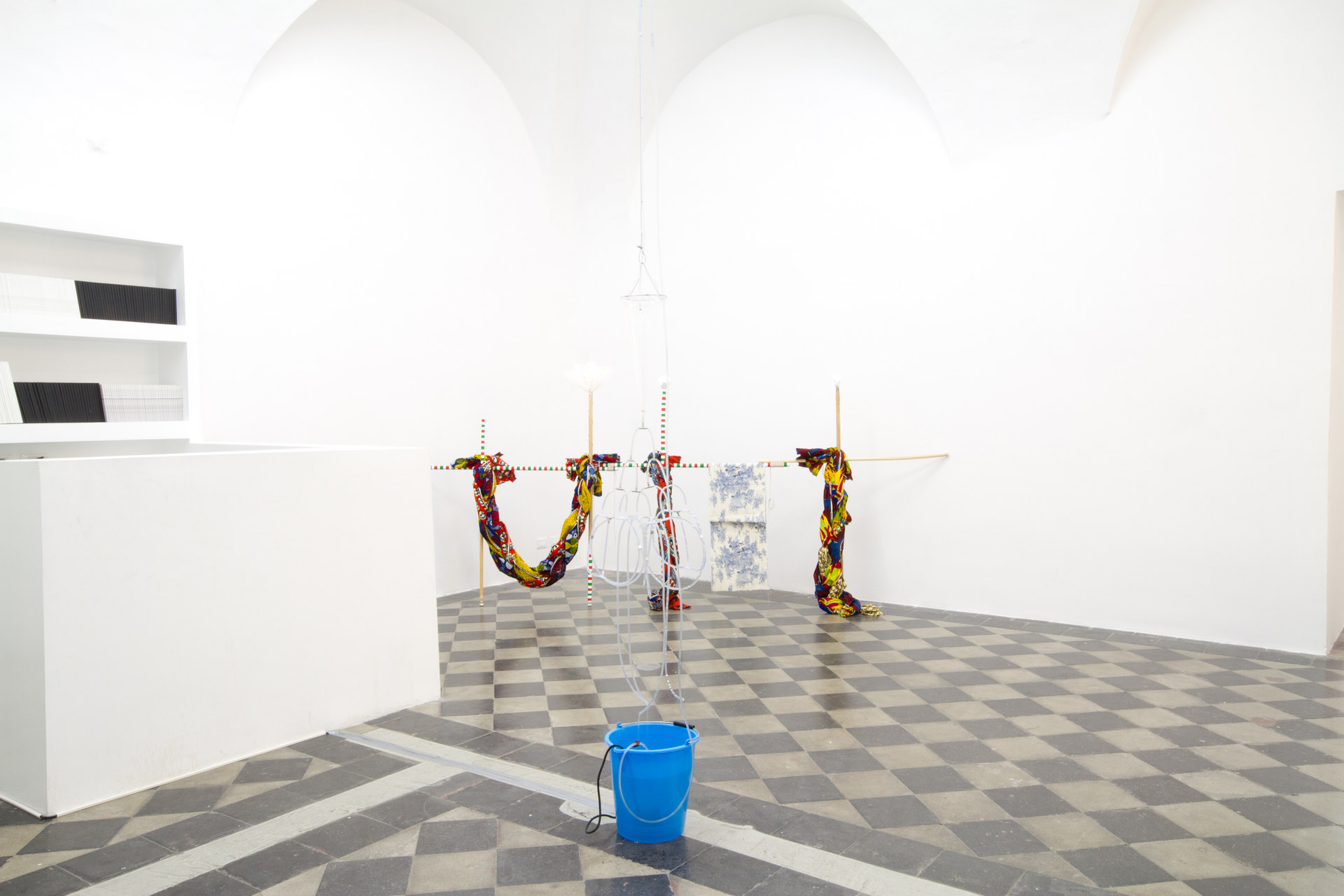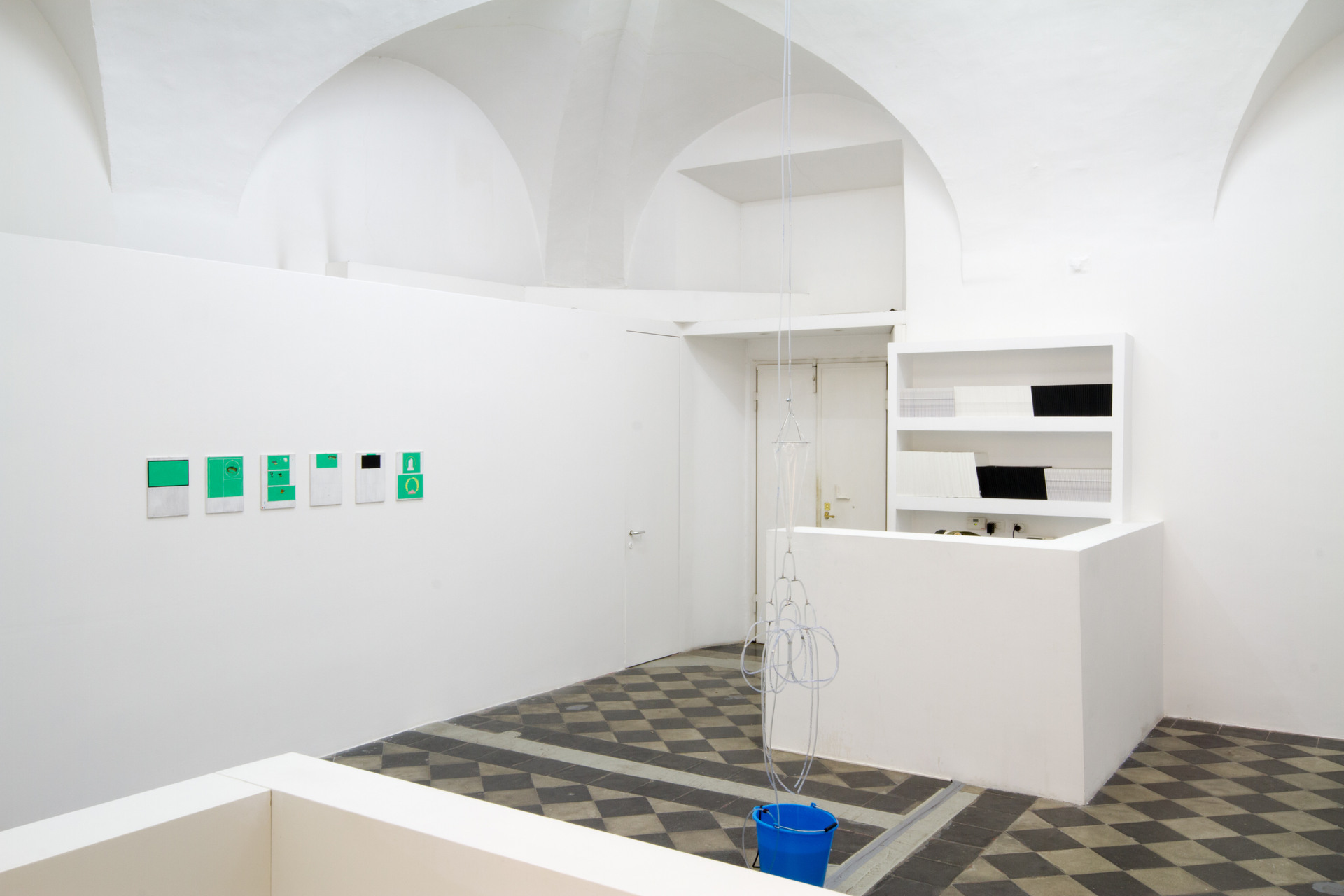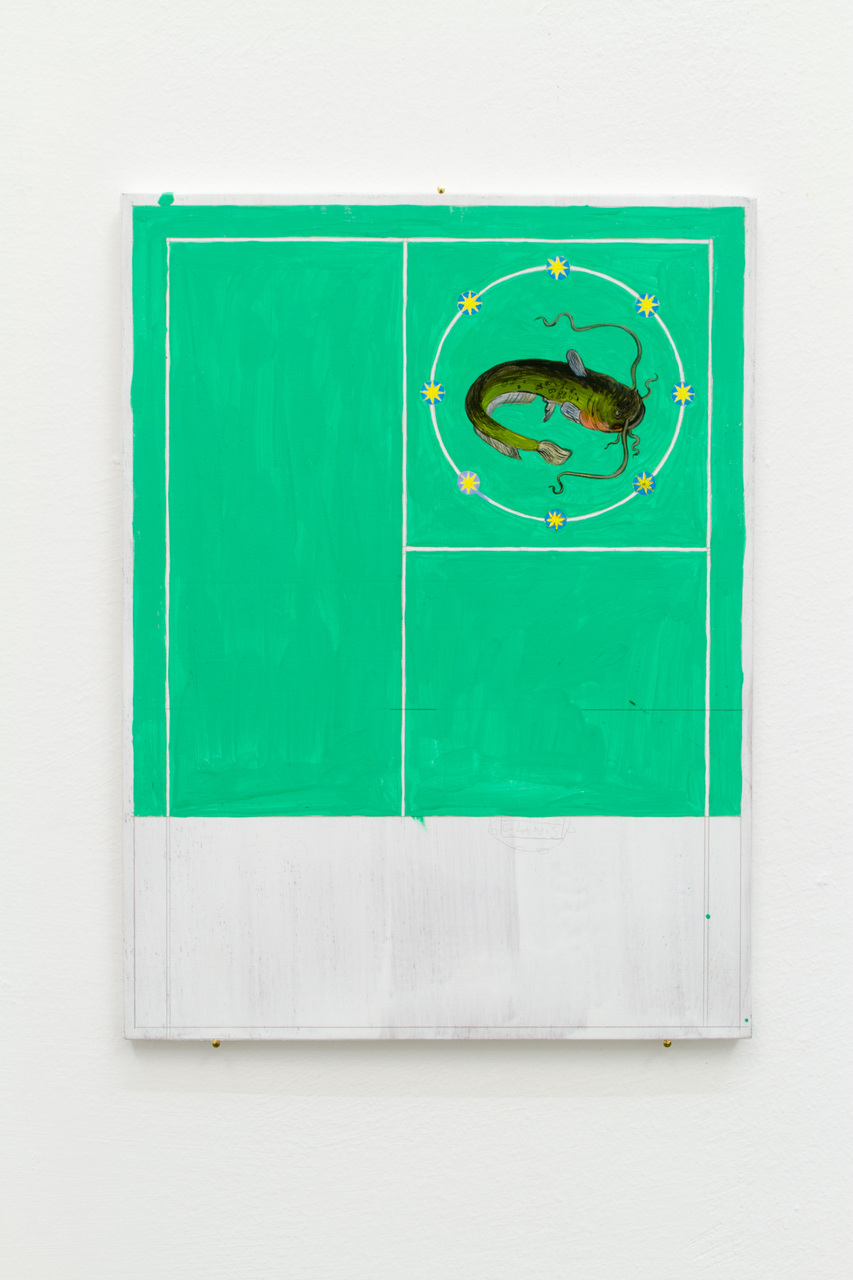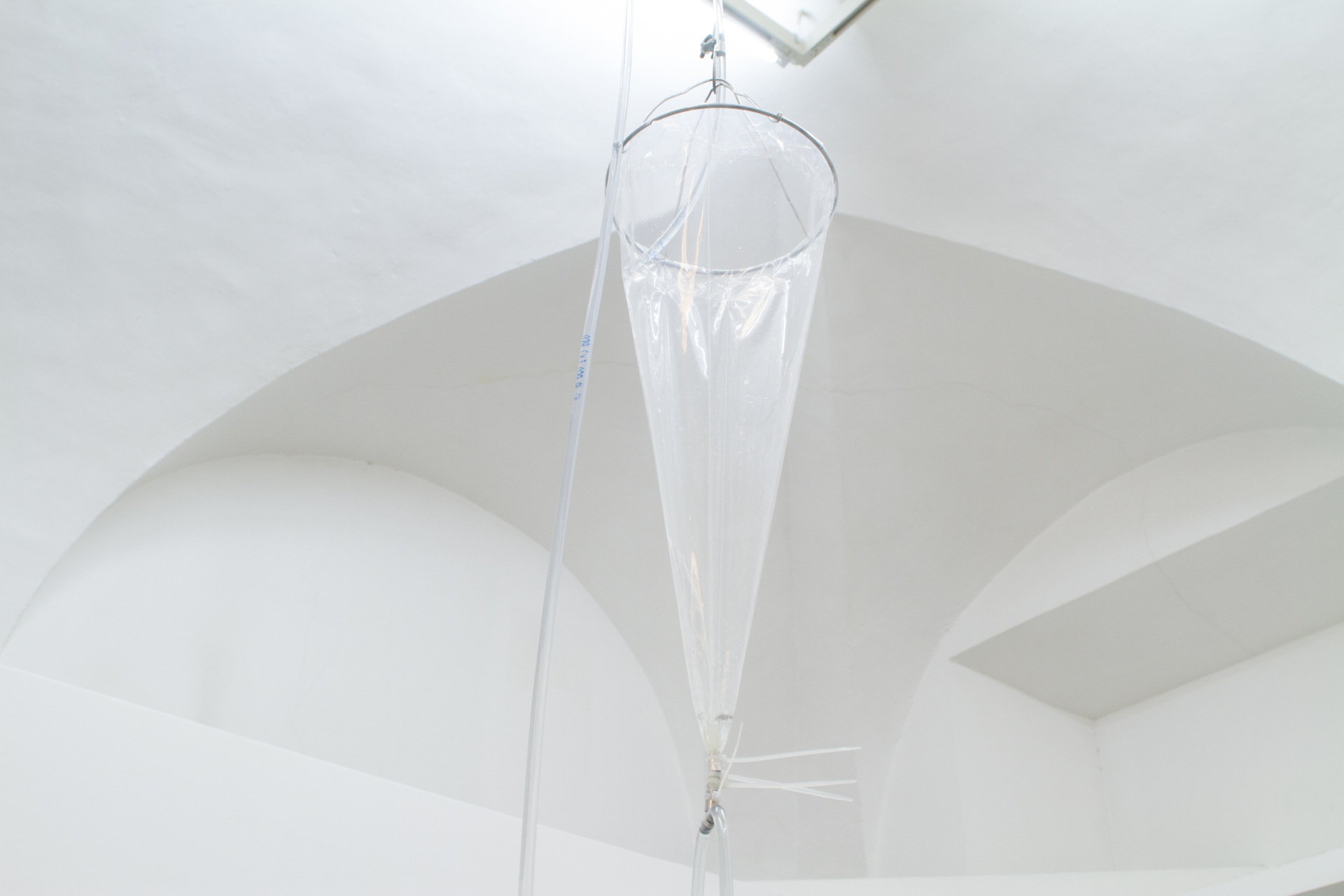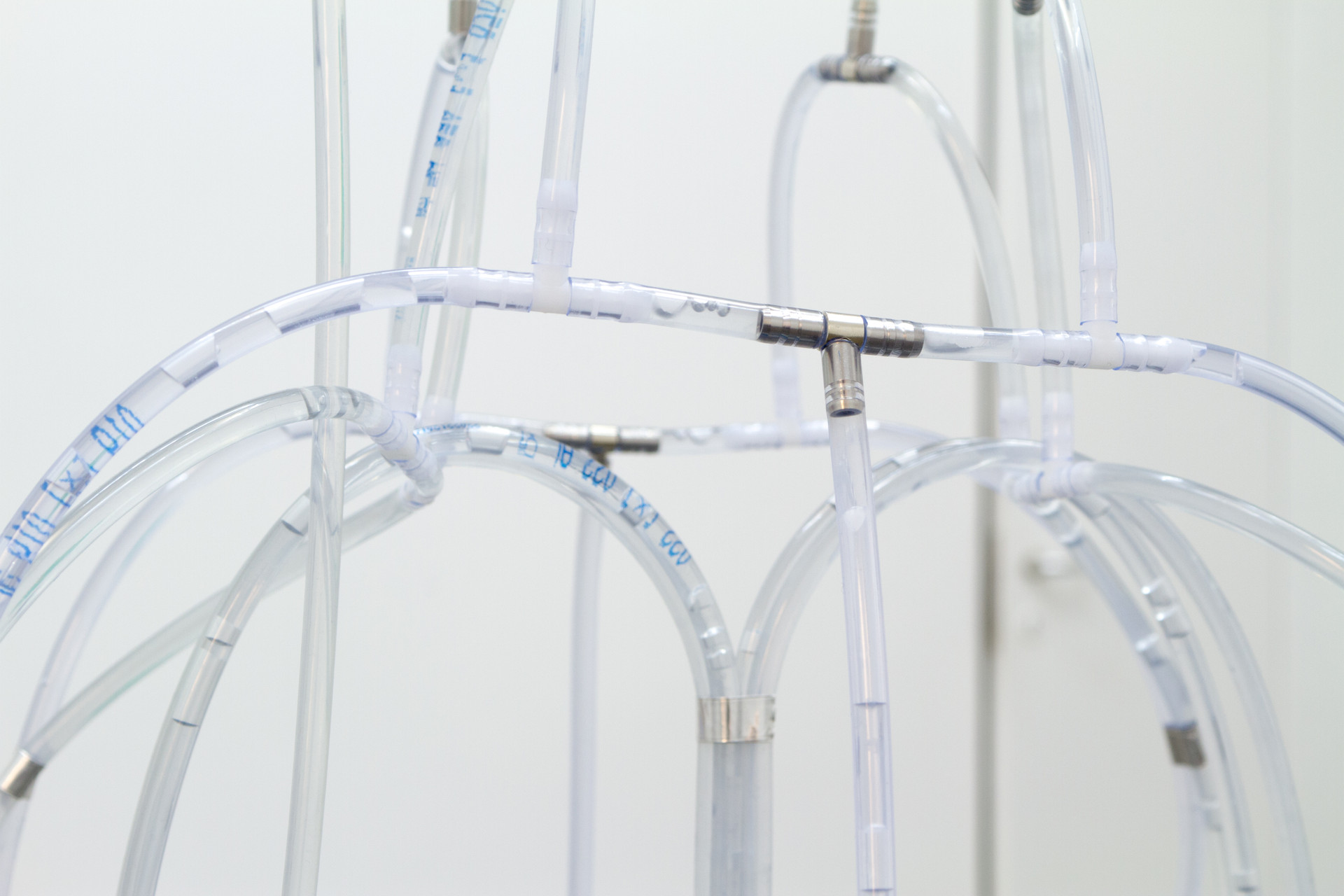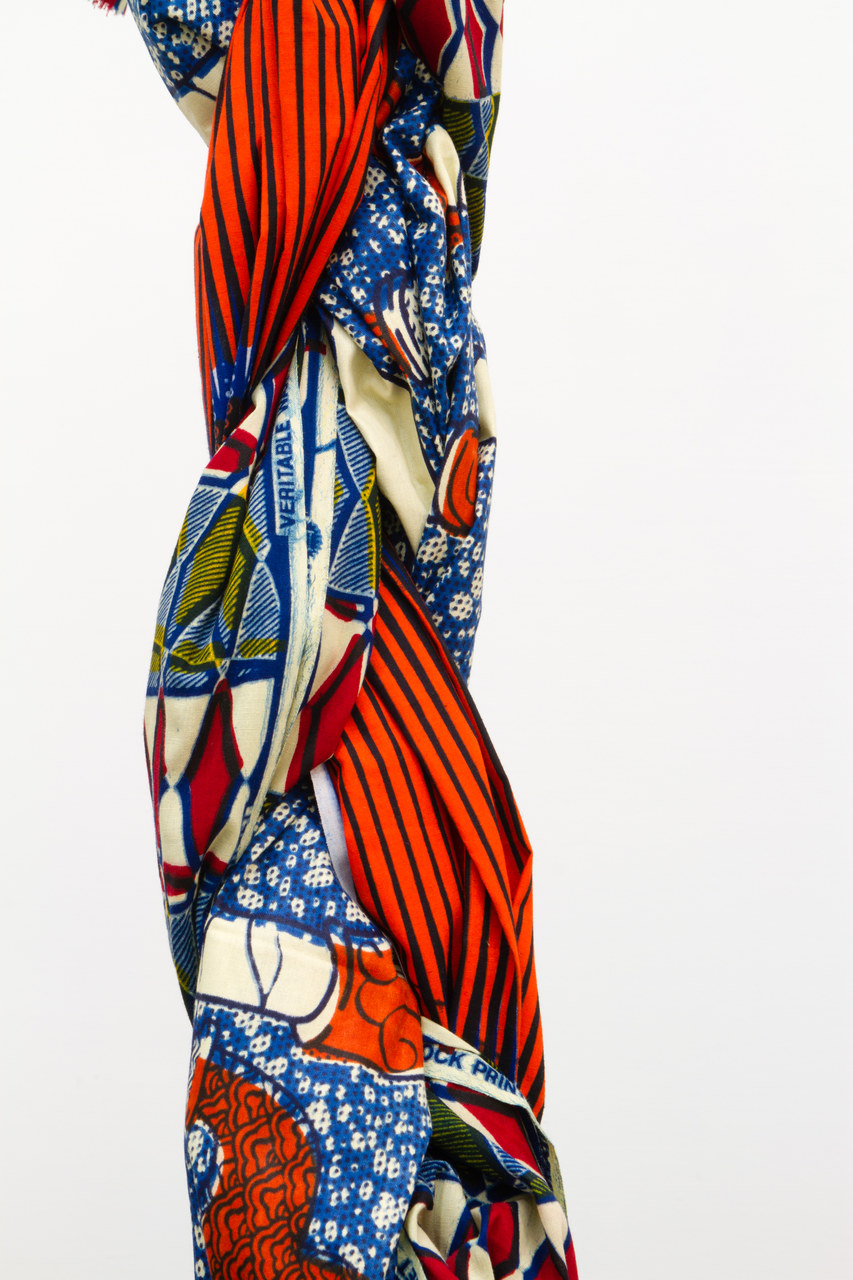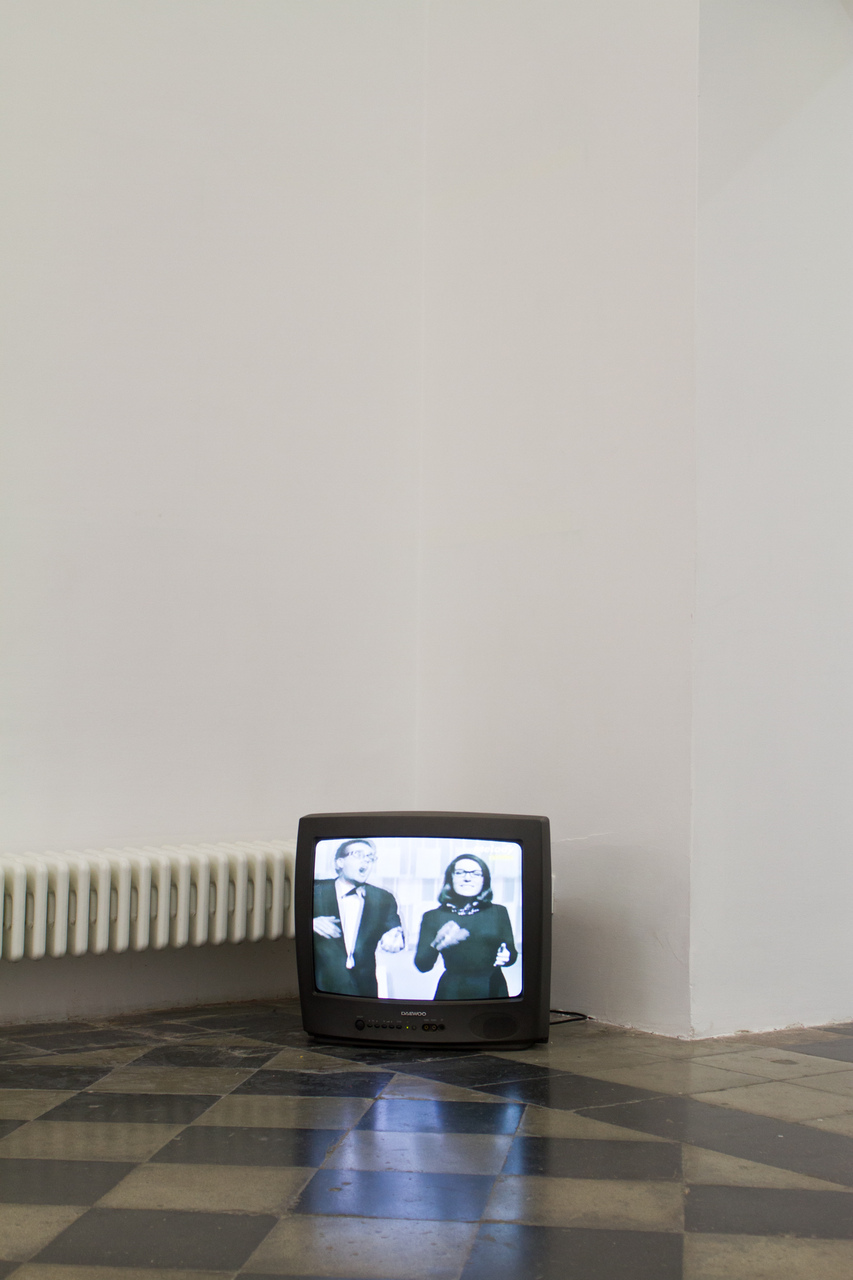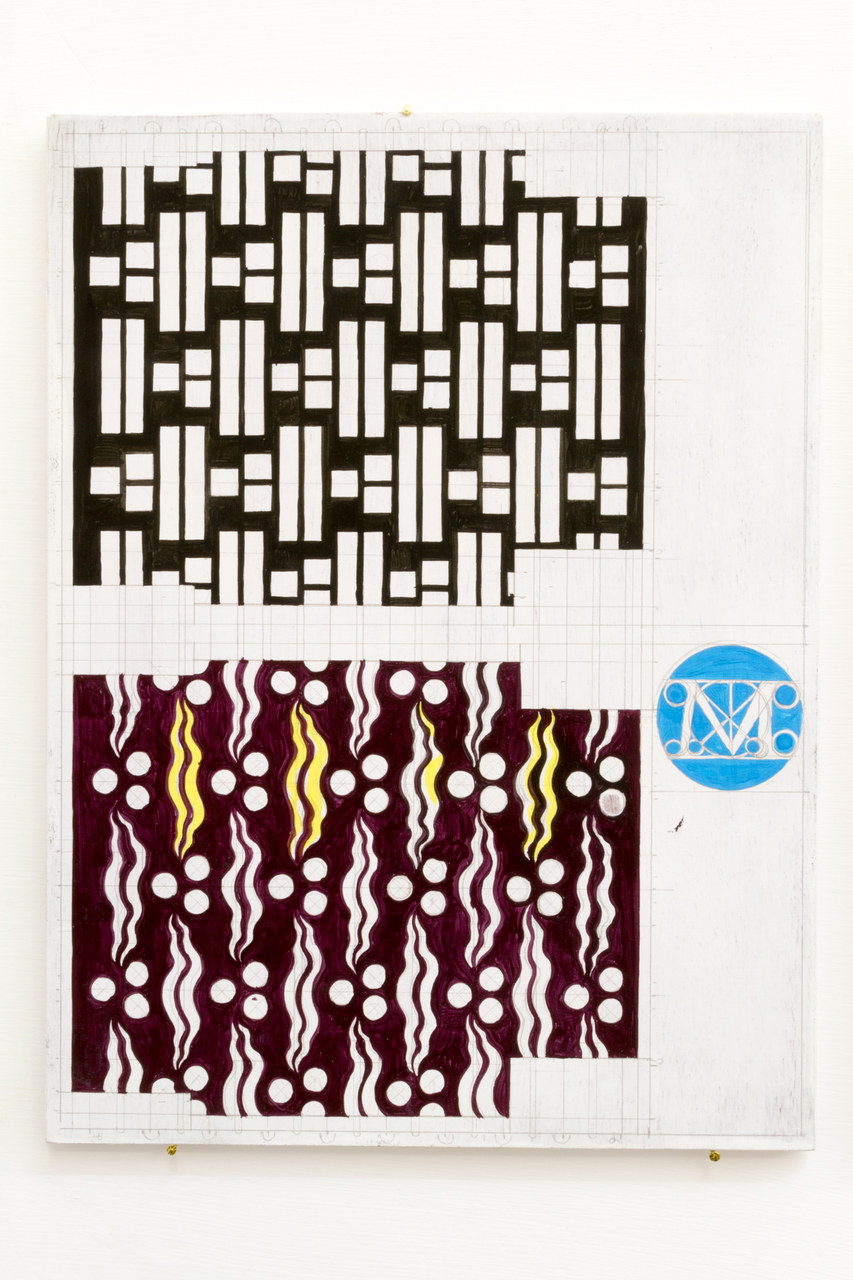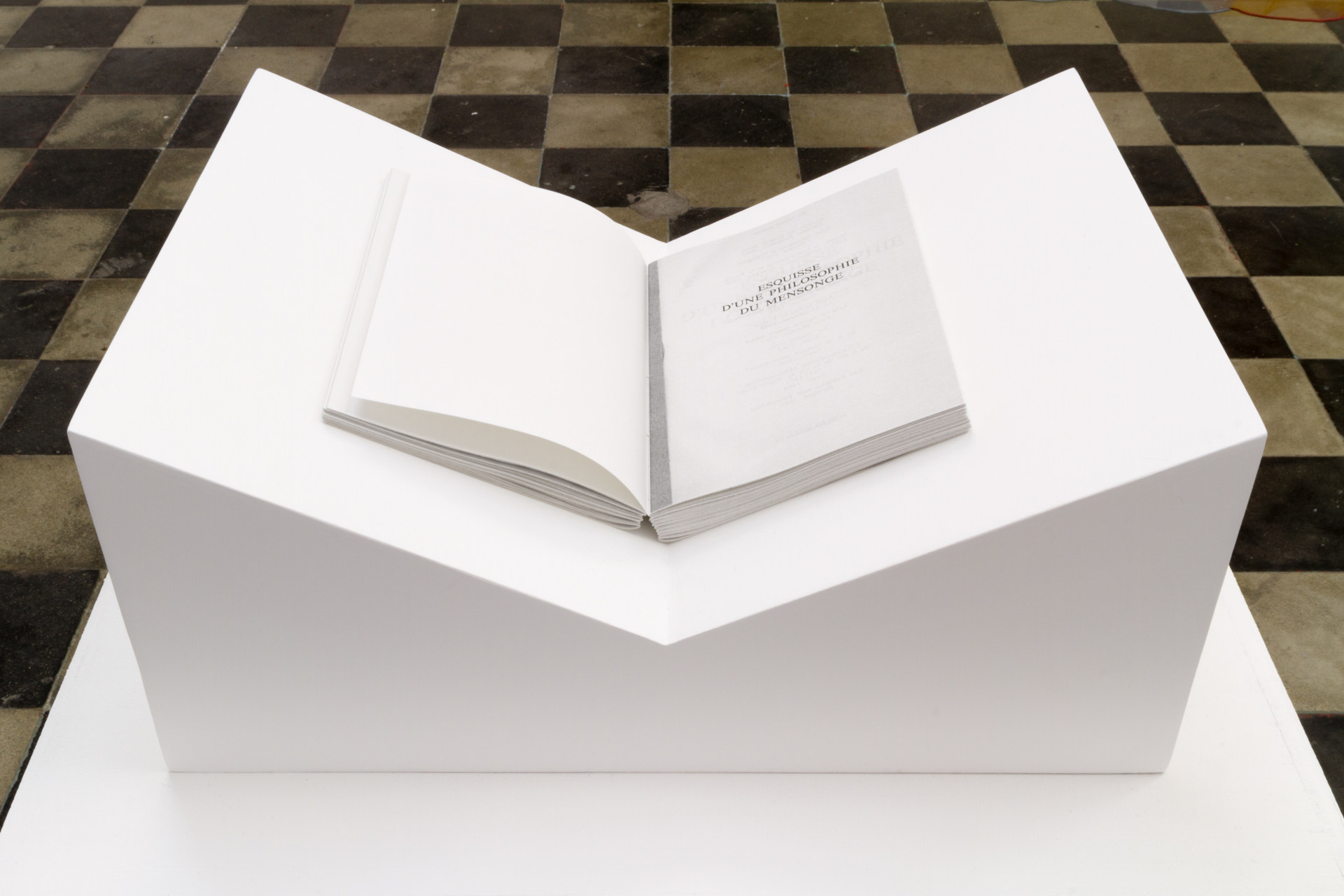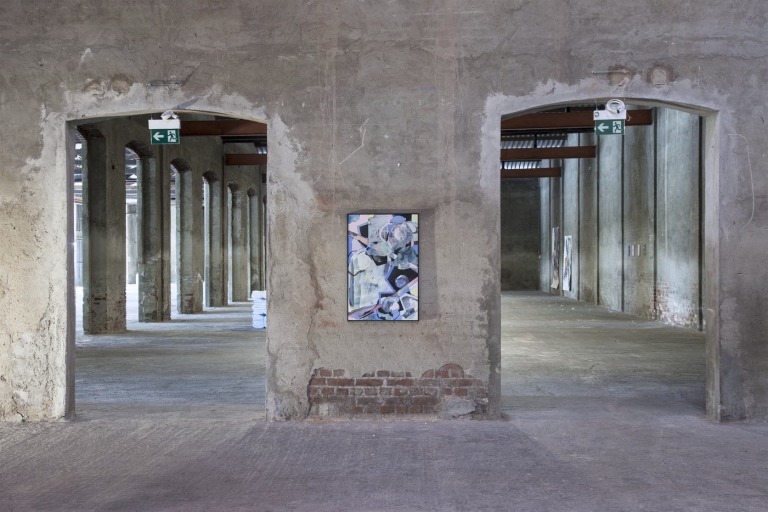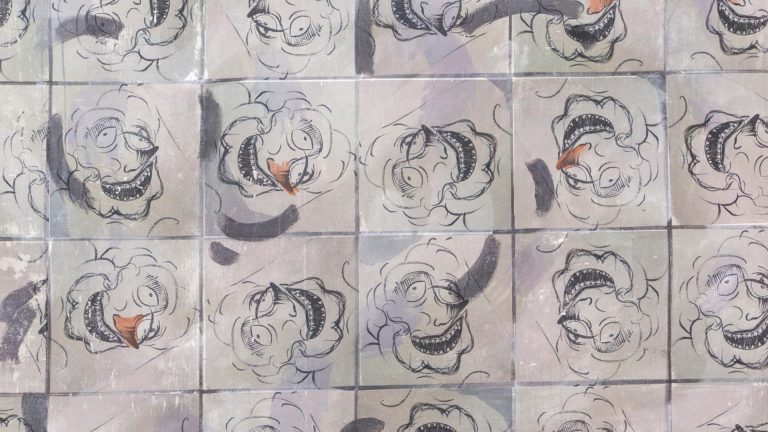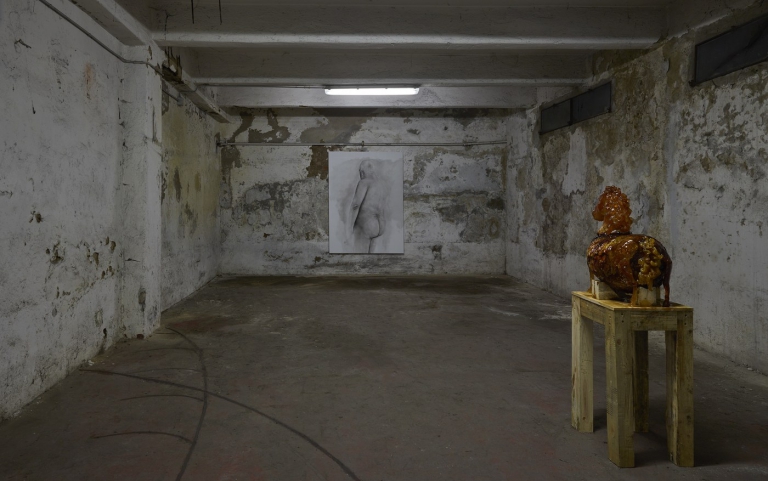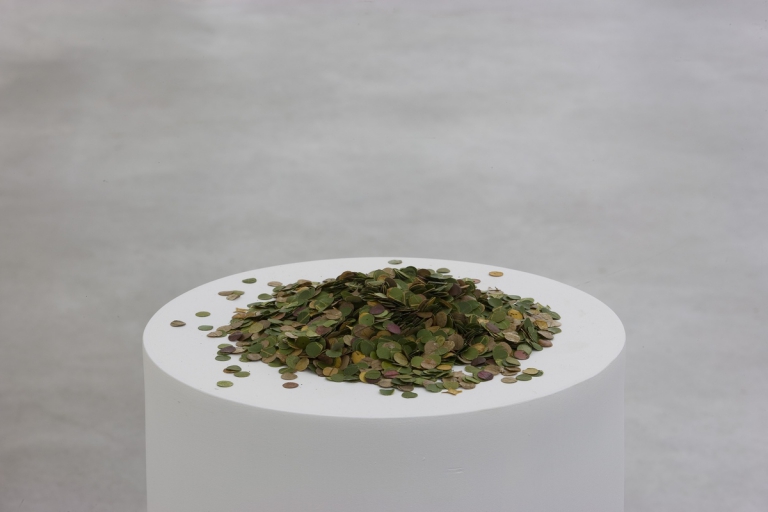Artists: Kasper Bosmans and Raffaella Crispino
Exhibition title: an alternate correspondence
Curated by: Marianne Derrien
Venue: 1/9unosunove, Rome, Italy
Date: February 20 – April 24, 2015
Photography: Images courtesy of the artists and 1/9unosunove
1/9unosunove is thrilled to present Kasper Bosmans c/o Raffaella Crispino – an alternate correspondence, the fourth and last exhibition in the cycle curated by Marianne Derrien.
The dialogue and correspondence between Crispino (Naples, 1979) and Bosmans (Lommel, 1990) began one year ago when they met through the Hisk residency program in Belgium. The exhibition they have conceived at 1/9unosunove examines the relation between time and culture, personal and collective History, narration and systems of thought.
Crispino and Bosmans have created together a common artwork, Fountain, main installation of the exhibition. Inspired by a Youtube footage of a DIY construction of a perpetuum mobile, the sculpture is the result of a naïve attempt to generate the moto perpetuo, which utopic goal is to create something that will avoid referring to time but that actualy reveals that the metric of times are unavoidable. This indoor fountain-machine, made of a bizarre network of plastic tubes hung to the ceiling of the gallery, filled with running water, evokes this former utopia investigating its aesthetic possibilities and physical capacities or failures.
Re-articuling the flux of time and space during the exhibition, this common piece offers a correlation with Raffaella Crispino‘s new body of work. Untitled (time zones), a long and light organza curtain, representing a colored planisphere of the time zones, made with the technique of the patchwork, relates to the geopolitic rules motivated by economic systems and political interests through a sensual and poetic dimension. This piece dialogues with a second work, an installation with various fabrics entitled Samia, refering to the young athlete Samia Yusuf Omar who died in 2012 on a clandestine boat in front of Sicily on her desperate way to participate to the London Olympics. Made with african cloth and toile de Jouy fabric representing the theme of The pleasures of the countryside in which Crispino has colored the characters in black, the installation acts like a critical tribute to lost dreams, clandestinity and the everyday drama of the sinkings ships off the coasts of Sicily, challenge and hope.
Considering our relationship to time and to space as a loop, Crispino questions the historic reinterpretation and the alteration of personal interpretations. Conceived and produced in Brussels, Ceci n’est pas un livre is a piece related to our possibility to get in or out of the artistic system. Each of the three volumes consists only of title pages from books of multiples genres. Page after page, the titles announce a book which seems to never begin but that nevertheless brings the reader to a singular history connected to the system of art as a request of permanence and continuity.
With an intuitive anthropological approach, young Belgian artist Kasper Bosmans looks towards the sociocultural traditions that shape art as well as our surroundings. Context-specific observations and designs — related to the natural world, popular customs, and local materials — inspire his artistic practice. Bosmans has a predilection for wide-ranging mediums, such as painting, drawing, and engineering, as well as for interdisciplinary readings of ethnographic rituals, early
Renaissance philosophy and fin-de-siècle novels.
Legend is a series of five gouaches on wood that attempts to clarify the procedures used to create all works that were included in the exhibition at the gallery. Bosmans accompanies this work with visual explanations of both the content and the process. Acting like a legend, it becomes a work of its own and gives keys to an alternative interpretation of the project. Showing elements from other works in show, Legend plays a major role in another work on view entitled Pearls and Waves. The fabric artwork reproduces the cintamani decorative pattern, a wavy motif of pearls and gems, possibly derived from a woven tigerpattern, which was believed to have a positive influence on the life of the beholder. According to the tradition, the cintamani stone is a wish-fulfilling gem that played an significant role in both Hindu and Buddhist society. The pattern got appropriated as a symbol of power and luxury by the Ottoman rulers and even functioned as a flag during the battle of Lepanto. Some scholars believe the Hindu-Buddhist motif was used in an ironic way by the Islamic rulers of the Ottoman Empire. Coming from Nepal where the artist had it woven, transited to Dubaï, then to Antwerpen and now in Rome, Pearls and Waves also tells the story of this displacement in time and locations.
As a result of their dialogue and common researches, Bosmans’ video O mio babbino caro, Maria Callas, seems to reply to Crispino’s video Quand on s’aime showing Michel Legrand and Nana Mouskouri singing the same song in two different moments of their life. In the same way, Bosmans’ footage is an excerpts’ compilation of live performances of Puccini’s famous opera. The similarity of the gestures recorded over the years is accentuated by removing all sound from the video.
Raffaella Crispino (Naples, 1979) currently lives and works in Brussels. Recent solo exhibitions include: HISK Open Studio, HISK, Ghent, Belgium (2013); Our Audience, Maison d’Art Actuel des Chartreux, Brussels, Belgium (2013); Weather Forecast, L’Ozio, Amsterdam, Holland (2013); 200 Différents Oiseaux, 1/9unosunove, Rome (2011); Transit 3, curated by A. Rispoli, M. Sheleff e E. Viola, CCA-Tel Aviv, Museo MADRE, Napoli (2009). Recent group exhibitions: Èdra, Connecting Landscapes, C. Stolfi curator, American Academy, Rome (2014); Répétition Générale, 1/9unosunove, Rome (2014); Towards which planet?, R. Gavarro curator, Canal05, Brussels, Belgium (2014); Art’Contest, De Markten, Brussels, Belgium (2013).
Kasper Bosmans (Ghent, 1990) currently lives and works in Lommel and Ghent (Belgium). Recent solo exhibitions: : Made to Measure: Fishing Rod, Experimental Intermedia, Ghent, Belgium (2014); Summary; fox, milk, smoke, Kasper Bosmans, Galerie Tatjana Pieters, Ghent, Belgium (2014); Kasper Bosmans & Philippe Van Snick, Nightshop, with Galerie Tatjana Pieters, Knokke, Belgium (2013). Recent group exhibitions: INBOX, A4 Multiple (4) van Lode Geens, M HKA, Antwerp, Belgium (2014); Belgium Performance Festival, Koninklijke Academie voor Schone Kunsten & MuHkA, Antwerp, Belgium (2013); The New Candour!, brought together by Hans Theys, Galerie Tatjana Pieters, Ghent, Belgium (2012).
Marianne Derrien. Born in 1981 in Berlin, independent curator and art critic based in Paris, Marianne Derrien worked as assistant at Serge Le Borgne ‘s gallery – Paris and was Project Manager for the exhibitions at the French Academy in Rome – Villa Médicis. Currently, she is editor-in-chief of the web site and coordinator of le Point Perché by The Absolut Company, new space in the Palais de Tokyo, Paris. Her curatorial practice is structured by the contextual analysis of a territory and its social, political and sociological history through testimonies / confessions / micro-history, mind control, body language within a personal or political context.




